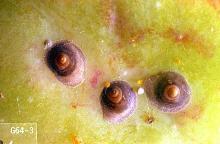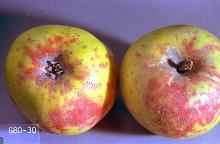Quadraspidiotus perniciosus
See:
Pest description and crop damage San Jose scale was introduced to the U.S. on flowering peach in the 1870s, and is now a pest of all tree fruits and many ornamental and wild trees and shrubs throughout the U.S., particularly in hot, dry climates. San Jose scale can be differentiated from other scale insects by the scale (shell) that covers the adult females. The scale is hard, gray to black, and cone-shape. The scale has a tiny white knob in the center with a series of grooves or rings around it.
Biology and life history San Jose scale overwinters in an immature state under a black shell. In spring, the tiny winged males emerge and mate with wingless females. Females give birth to live young about a month later (no eggs are seen). The young scale (called "crawlers") are very small, flattened, and yellow, and move around on bark and foliage before settling down to feed. Young scale also can be dispersed by wind, rain, irrigation, or by the movement of people and machinery. A few days later, they secrete a waxy coating over their body that protects them from pesticides. From this point, female scale do not move. Crawlers appear during June and July and again in August to September. There are two generations per year.
Scouting and thresholds In cherry orchards, leaves of infested trees do not drop in fall, making detection straightforward. Inspect twigs during the dormant season for scale. Pay particular attention to weak plants. Observe the young bark for purplish-red halos, which indicate infestation. The crawlers are best observed during June and July with a 10X magnifying glass. Monitor crawlers by wrapping a piece of black sticky tape around an infested branch with the sticky side out.
For more information
Johnson, W.T. and H.H. Lyon (1991), Insects That Feed on Trees and Shrubs, 2nd ed., Cornell University Press (p. 386).



